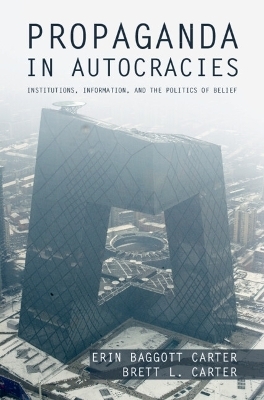
Propaganda in Autocracies
Institutions, Information, and the Politics of Belief
Seiten
2023
Cambridge University Press (Verlag)
978-1-009-27124-0 (ISBN)
Cambridge University Press (Verlag)
978-1-009-27124-0 (ISBN)
This book draws on the first global dataset of autocratic propaganda, encompassing eight million newspaper articles from 59 countries. It documents dramatic variation in propaganda across autocracies and explain why different autocrats employ different propaganda strategies. The book will interest anyone who cares about dictatorship and democracy.
A dictator's power is secure, the authors begin in this muscular, impressive study, only as long as citizens believe in it. When citizens suddenly believe otherwise, a dictator's power is anything but, as the Soviet Union's collapse revealed. This conviction – that power rests ultimately on citizens' beliefs – compels the world's autocrats to invest in sophisticated propaganda. This study draws on the first global data set of autocratic propaganda, encompassing nearly eight million newspaper articles from fifty-nine countries in six languages. The authors document dramatic variation in propaganda across autocracies: in coverage of the regime and its opponents, in narratives about domestic and international life, in the threats of violence issued to citizens, and in the domestic events that shape it. The book explains why Russian President Vladimir uses Donald Trump as a propaganda tool and why Chinese state propaganda is more effusive than any point since the Cultural Revolution.
A dictator's power is secure, the authors begin in this muscular, impressive study, only as long as citizens believe in it. When citizens suddenly believe otherwise, a dictator's power is anything but, as the Soviet Union's collapse revealed. This conviction – that power rests ultimately on citizens' beliefs – compels the world's autocrats to invest in sophisticated propaganda. This study draws on the first global data set of autocratic propaganda, encompassing nearly eight million newspaper articles from fifty-nine countries in six languages. The authors document dramatic variation in propaganda across autocracies: in coverage of the regime and its opponents, in narratives about domestic and international life, in the threats of violence issued to citizens, and in the domestic events that shape it. The book explains why Russian President Vladimir uses Donald Trump as a propaganda tool and why Chinese state propaganda is more effusive than any point since the Cultural Revolution.
Part I. Foundations: 1. Persuasion and domination; 2. A theory of autocratic propaganda; 3. A global dataset of autocratic propaganda; Part II. The Political Origins of Propaganda Strategies: 4. The politics of pro-regime propaganda; 5. Narrating the domestic; 6. Narrating the world; 7. Threatening citizens with repression; Part III. The Propaganda Calendar: 8. The propagandist's dilemma; 9. Memory and forgetting; Part IV. Propaganda, Protest, and the Future: 10. Propaganda and protest; 11. Conclusion; List of figures; List of tables.
| Erscheinungsdatum | 05.09.2023 |
|---|---|
| Reihe/Serie | Political Economy of Institutions and Decisions |
| Zusatzinfo | Worked examples or Exercises; 52 Tables, black and white; 84 Line drawings, black and white |
| Verlagsort | Cambridge |
| Sprache | englisch |
| Gewicht | 899 g |
| Themenwelt | Sozialwissenschaften ► Kommunikation / Medien ► Journalistik |
| Sozialwissenschaften ► Politik / Verwaltung ► Vergleichende Politikwissenschaften | |
| Wirtschaft ► Volkswirtschaftslehre ► Wirtschaftspolitik | |
| ISBN-10 | 1-009-27124-5 / 1009271245 |
| ISBN-13 | 978-1-009-27124-0 / 9781009271240 |
| Zustand | Neuware |
| Haben Sie eine Frage zum Produkt? |
Mehr entdecken
aus dem Bereich
aus dem Bereich


